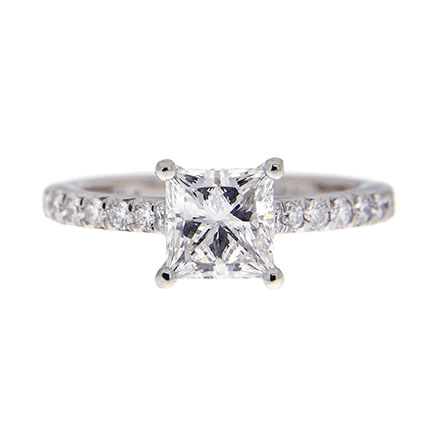The Elements of a Princess Cut Diamond

Princess cut diamonds are square shaped stones introduced in 1979. When viewed from above, they feature a brilliant X pattern. Their design helps them stand out from brilliant cuts. Princess cut diamond rings are second in popularity only to round brilliants.
Mixed cut diamonds, such as the princess, combine the qualities of step and brilliant gems. Like the former, they sacrifice less rough to get the desired appearance. As with the latter, they reflect large amounts of light. Their brilliance and economical cut helps keep princess diamonds in demand.
The upper half of a diamond is known as a crown. A princess cut’s crown is step cut, with parallel facets. The number of facet rows varies between stones. Its table, or top facet, is broad, taking up most of the crown. Compared to the jewel’s total depth, the crown is shallow.
The lower half of a diamond is called the pavilion. In a princess cut, the pavilion provides the stone’s brilliance. This portion is made of pavilion main, chevron and half-moon facets. Pavilion mains reach from the center to the corner of the jewel. Half-moons are broad triangles which stretch across the sides of the square. Between the pavilion mains and half-moons are two or more chevrons.
There are some things to keep in mind when shopping for princess diamond bands. The cut looks best with parallel sides and right-angled corners. Its settings should protect tips from possible damage. As the diamond rings move, they should produce a glitter that’s pleasing to your eye. The prettiest diamonds are those that make you happy.





